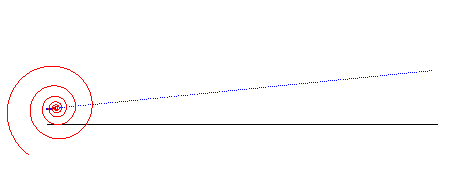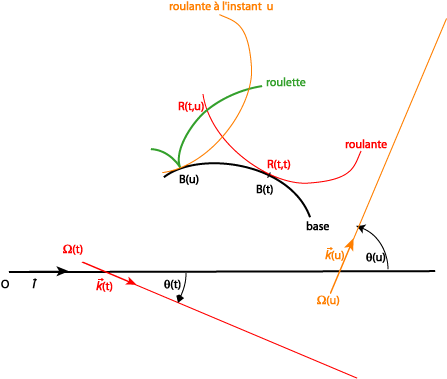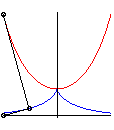BASE CURVE, ROLLING CURVE AND ROULETTES
IN A RIGID MOTION OF A MOVING PLANE OVER A FIXED PLANE

| next curve | previous curve | 2D curves | 3D curves | surfaces | fractals | polyhedra |
BASE CURVE, ROLLING CURVE AND ROULETTES
IN A RIGID MOTION OF A MOVING PLANE OVER A FIXED PLANE

| The movement of a plane over a fixed plane has been studied globally by W. H. Besant in 1869. Dürer in 1525, D. Bernoulli, La Hire, Desargues, Leibniz, Newton, Maxwell, etc., were precursors and studied some specific cases. |
| The base curve of the movement of a plane over
a fixed plane is the curve generated on the fixed plane by the instant
centre of rotation of the moving plane.
The rolling curve is the curve generated by this
point on the moving plane.
The roulettes (or trajectories) are the
curves traced on the fixed plane by the points of the moving plane.
|
 |
 |
Let The affix of a point M = M(t) is m=m(t) in the reference frame and Let N(t, u), of affix n(t, u), be the point whose position in the moving frame at time t is the position of the point M at time u. We have: |
| At time t, the instant centre of rotation We can then prove that The rolling curve is, at any time t, the curve described by the points of affix A roulette is the trajectory of a point M fixed in the moving frame. It is defined by Example of calculation of a roulette, knowing the base and the rolling curve, for the cycloid: parameters |
| Here is, in the case where the vectors and the rolling curve's Cartesian parametrization is |
Examples:
- When the moving plane is the plane
tied to the tangent of a curve, the base is the evolute
of this curve, and the rolling curve is the normal. The curve is one of
the roulettes.
- When the rolling curve is the reflection
of the base with respect to a tangent, the roulette is the orthotomic
curve of the base with respect to the reflection of the tracing point across
the tangent (this point is fixed); for example:
- the roulettes
of the centre of an ellipse rolling on the reflection of an ellipse are
Booth's
ovals
- the roulettes
of the centre of a hyperbola rolling on the reflection of a hyperbola are
Booth's
lemniscates
- the roulette
of the vertex of a parabola rolling on the reflection of a parabola is
Diokles'
cissoid
An exhaustive list of examples is located at pedal.
- The examples where the base
is a line can be found on this specific
page.
- When the rolling curve is
a line and the tracing point is on the line, the roulette is an involute
of the base.
- When a roulette is a line,
the base and the rolling curve form a wheel-road
couple, whereas when a roulette is circular, the base and the
rolling curve have mating gear profiles.
Other examples:
| base | rolling curve | tracing point | roulette |
| circle | circle | on the rolling circle | centred cycloid |
| circle | circle | any | centred trochoid |
| circle | line | located on the half plane containing the circle, at a distance from the line equal to the radius of the circle | Archimedean spiral |
| circle | equiangular spiral | pole of the spiral | circle concentric to the base |
| catenary | line | see figure on the right | line (base of the catenary)
 |
| parabola | Kampyle | on the transversal axis of the Kampyle | conchoid of Nicomedes |
| Kampyle | parabola | kappa | |
| quadrifolium | ellipse | double egg | |
| cycloid | cardioid | pole of the cardioid | involute of cycloid |
Remark: even when the base and the rolling curve are algebraic, the roulette can be transcendental (cf. cycloid).
More generally, the notion of roulette of a fixed curve
on the moving plane refers to the envelope of this curve in the fixed
plane. The curvature centres of theses two curves are related through the
Euler-Savary
theorem.
Examples:
- the base is the envelope of the
rolling curve (which is the only curve that does not slip on the roulette).
- the directrix of a parabola rolling
on a line envelopes the catenary
traced by its focus.
- a diameter of a circle rolling without
slipping on a line envelopes a cycloid,
and any line of the moving plane envelopes an involute of cycloid.
- a diameter of a circle rolling without
slipping on the interior of a circle of double radius envelopes an astroid,
and the line perpendicular to this diameter at one of its extremities envelopes
a Maltese cross; more
generally, with circles of any radius, the envelopes of the diameter of
the rolling circle are the centred
cycloids and the envelopes of any straight line are involutes of centred
cycloids.
- the negative
pedal of a curve is the roulette of the perpendicular at the point
M
to the line (OM), when M describes the curve, the moving
plane being the plane in which M and (OM) are fixed.
The movement of a sphere over an isometric sphere gives
rise to notions of base, rolling curve and roulettes absolutely similar
to the case of the movement of a plane over a fixed plane. See for example
the spherical
trochoids of second type.
| next curve | previous curve | 2D curves | 3D curves | surfaces | fractals | polyhedra |
© Robert FERRÉOL 2017